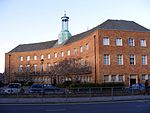St John, Friern Barnet
19th-century Church of England church buildingsChurch of England church buildings in the London Borough of BarnetDiocese of LondonFriern BarnetGrade II* listed buildings in the London Borough of Barnet ... and 2 more
Grade II* listed churches in LondonUse British English from February 2015

St John the Evangelist is an Anglican church on Friern Barnet Road in north London. It is a late example of the Gothic Revival Style by Victorian architect John Loughborough Pearson, begun in 1890-91 and completed after his death by his son Frank Loughborough Pearson.
Excerpt from the Wikipedia article St John, Friern Barnet (License: CC BY-SA 3.0, Authors, Images).St John, Friern Barnet
Friern Barnet Road, London Friern Barnet (London Borough of Barnet)
Geographical coordinates (GPS) Address Website External links Nearby Places Show on map
Geographical coordinates (GPS)
| Latitude | Longitude |
|---|---|
| N 51.613055555556 ° | E -0.15444444444444 ° |
Address
St John's Parish Centre
Friern Barnet Road
N11 3DP London, Friern Barnet (London Borough of Barnet)
England, United Kingdom
Open on Google Maps






